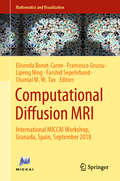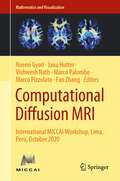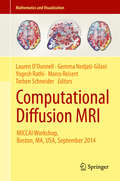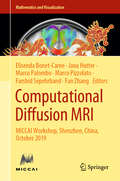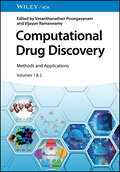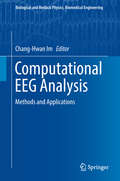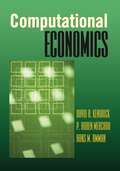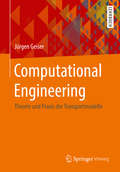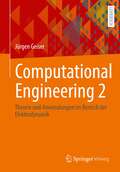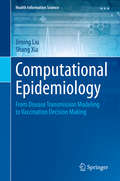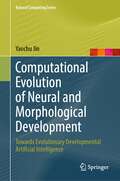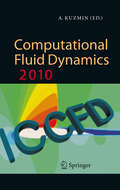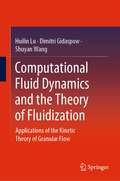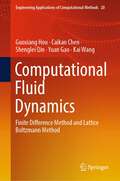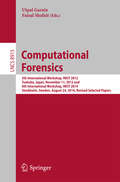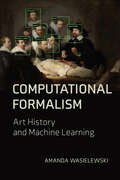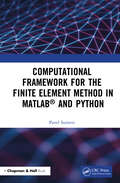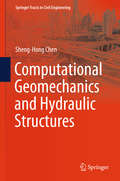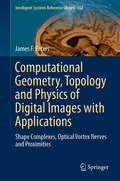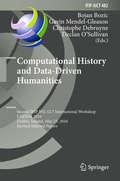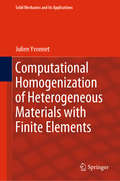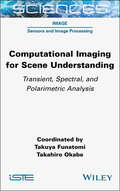- Table View
- List View
Computational Diffusion MRI: International MICCAI Workshop, Granada, Spain, September 2018 (Mathematics and Visualization)
by Francesco Grussu Lipeng Ning Chantal M. Tax Elisenda Bonet-Carne Farshid SepehrbandThis volume gathers papers presented at the Workshop on Computational Diffusion MRI (CDMRI’18), which was held under the auspices of the International Conference on Medical Image Computing and Computer Assisted Intervention in Granada, Spain on September 20, 2018. It presents the latest developments in the highly active and rapidly growing field of diffusion MRI. The reader will find papers on a broad range of topics, from the mathematical foundations of the diffusion process and signal generation, to new computational methods and estimation techniques for the in-vivo recovery of microstructural and connectivity features, as well as harmonisation and frontline applications in research and clinical practice. The respective papers constitute invited works from high-profile researchers with a specific focus on three topics that are now gaining momentum within the diffusion MRI community: i) machine learning for diffusion MRI; ii) diffusion MRI outside the brain (e.g. in the placenta); and iii) diffusion MRI for multimodal imaging. The book shares new perspectives on the latest research challenges for those currently working in the field, but also offers a valuable starting point for anyone interested in learning computational techniques in diffusion MRI. It includes rigorous mathematical derivations, a wealth of full-colour visualisations, and clinically relevant results. As such, it will be of interest to researchers and practitioners in the fields of computer science, MRI physics and applied mathematics alike.
Computational Diffusion MRI: International MICCAI Workshop, Lima, Peru, October 2020 (Mathematics and Visualization)
by Fan Zhang Jana Hutter Marco Palombo Marco Pizzolato Noemi Gyori Vishwesh NathThis book gathers papers presented at the Workshop on Computational Diffusion MRI, CDMRI 2020, held under the auspices of the International Conference on Medical Image Computing and Computer-Assisted Intervention (MICCAI), which took place virtually on October 8th, 2020, having originally been planned to take place in Lima, Peru.This book presents the latest developments in the highly active and rapidly growing field of diffusion MRI. While offering new perspectives on the most recent research challenges in the field, the selected articles also provide a valuable starting point for anyone interested in learning computational techniques for diffusion MRI. The book includes rigorous mathematical derivations, a large number of rich, full-colour visualizations, and clinically relevant results. As such, it is of interest to researchers and practitioners in the fields of computer science, MRI physics, and applied mathematics. The reader will find numerous contributions covering a broad range of topics, from the mathematical foundations of the diffusion process and signal generation to new computational methods and estimation techniques for the in-vivo recovery of microstructural and connectivity features, as well as diffusion-relaxometry and frontline applications in research and clinical practice.
Computational Diffusion MRI: MICCAI Workshop, Boston, MA, USA, September 2014 (Mathematics and Visualization)
by Lauren O'Donnell Gemma Nedjati-Gilani Yogesh Rathi Marco Reisert Torben SchneiderThis book contains papers presented at the 2014 MICCAI Workshop on Computational Diffusion MRI, CDMRI’14. Detailing new computational methods applied to diffusion magnetic resonance imaging data, it offers readers a snapshot of the current state of the art and covers a wide range of topics from fundamental theoretical work on mathematical modeling to the development and evaluation of robust algorithms and applications in neuroscientific studies and clinical practice.Inside, readers will find information on brain network analysis, mathematical modeling for clinical applications, tissue microstructure imaging, super-resolution methods, signal reconstruction, visualization, and more. Contributions include both careful mathematical derivations and a large number of rich full-color visualizations.Computational techniques are key to the continued success and development of diffusion MRI and to its widespread transfer into the clinic. This volume will offer a valuable starting point for anyone interested in learning computational diffusion MRI. It also offers new perspectives and insights on current research challenges for those currently in the field. The book will be of interest to researchers and practitioners in computer science, MR physics, and applied mathematics.
Computational Diffusion MRI: MICCAI Workshop, Shenzhen, China, October 2019 (Mathematics and Visualization)
by Fan Zhang Elisenda Bonet-Carne Farshid Sepehrband Jana Hutter Marco Palombo Marco PizzolatoThis volume gathers papers presented at the Workshop on Computational Diffusion MRI (CDMRI 2019), held under the auspices of the International Conference on Medical Image Computing and Computer Assisted Intervention (MICCAI), which took place in Shenzhen, China on October 17, 2019. This book presents the latest advances in the rapidly expanding field of diffusion MRI. It shares new perspectives on the latest research challenges for those currently working in the field, but also offers a valuable starting point for anyone interested in learning about computational techniques in diffusion MRI. The book includes rigorous mathematical derivations, a wealth of rich, full-colour visualisations and extensive clinically relevant results. As such, it will be of interest to researchers and practitioners in the fields of computer science, MRI physics and applied mathematics. Readers will find contributions covering a broad range of topics, from the mathematical foundations of the diffusion process and signal generation, to new computational methods and estimation techniques for the in vivo recovery of microstructural and connectivity features, as well as diffusion-relaxometry and frontline applications in research and clinical practice. This edition includes invited works from high-profile researchers with a specific focus on three new and important topics that are gaining momentum within the diffusion MRI community, including diffusion MRI signal acquisition and processing strategies, machine learning for diffusion MRI, and diffusion MRI outside the brain and clinical applications.
Computational Discrete Mathematics
by Sriram Pemmaraju Steven SkienaThis book was first published in 2003. Combinatorica, an extension to the popular computer algebra system Mathematica®, is the most comprehensive software available for teaching and research applications of discrete mathematics, particularly combinatorics and graph theory. This book is the definitive reference/user's guide to Combinatorica, with examples of all 450 Combinatorica functions in action, along with the associated mathematical and algorithmic theory. The authors cover classical and advanced topics on the most important combinatorial objects: permutations, subsets, partitions, and Young tableaux, as well as all important areas of graph theory: graph construction operations, invariants, embeddings, and algorithmic graph theory. In addition to being a research tool, Combinatorica makes discrete mathematics accessible in new and exciting ways to a wide variety of people, by encouraging computational experimentation and visualization. The book contains no formal proofs, but enough discussion to understand and appreciate all the algorithms and theorems it contains.
Computational Drug Discovery: Methods and Applications
by Vasanthanathan Poongavanam Vijayan RamaswamyComputational Drug Discovery A comprehensive resource that explains a wide array of computational technologies and methods driving innovation in drug discovery Computational Drug Discovery: Methods and Applications (2 volume set) covers a wide range of cutting-edge computational technologies and computational chemistry methods that are transforming drug discovery. The book delves into recent advances, particularly focusing on artificial intelligence (AI) and its application for protein structure prediction, AI-enabled virtual screening, and generative modeling for compound design. Additionally, it covers key technological advancements in computing such as quantum and cloud computing that are driving innovations in drug discovery. Furthermore, dedicated chapters that addresses the recent trends in the field of computer aided drug design, including ultra-large-scale virtual screening for hit identification, computational strategies for designing new therapeutic modalities like PROTACs and covalent inhibitors that target residues beyond cysteine are also presented. To offer the most up-to-date information on computational methods utilized in computational drug discovery, it covers chapters highlighting the use of molecular dynamics and other related methods, application of QM and QM/MM methods in computational drug design, and techniques for navigating and visualizing the chemical space, as well as leveraging big data to drive drug discovery efforts. The book is thoughtfully organized into eight thematic sections, each focusing on a specific computational method or technology applied to drug discovery. Authored by renowned experts from academia, pharmaceutical industry, and major drug discovery software providers, it offers an overview of the latest advances in computational drug discovery. Key topics covered in the book include: Application of molecular dynamics simulations and related approaches in drug discovery The application of QM, hybrid approaches such as QM/MM, and fragment molecular orbital framework for understanding protein-ligand interactions Adoption of artificial intelligence in pre-clinical drug discovery, encompassing protein structure prediction, generative modeling for de novo design, and virtual screening. Techniques for navigating and visualizing the chemical space, along with harnessing big data to drive drug discovery efforts. Methods for performing ultra-large-scale virtual screening for hit identification. Computational strategies for designing new therapeutic models, including PROTACs and molecular glues. In silico ADMET approaches for predicting a variety of pharmacokinetic and physicochemical endpoints. The role of computing technologies like quantum computing and cloud computing in accelerating drug discovery This book will provide readers an overview of the latest advancements in computational drug discovery and serve as a valuable resource for professionals engaged in drug discovery.
Computational EEG Analysis: Methods and Applications (Biological and Medical Physics, Biomedical Engineering)
by Chang-Hwan ImThis book introduces and reviews all of the currently available methods being used for computational electroencephalogram (EEG) analysis, from the fundamentals through to the state-of-the-art. The aim of the book is to help biomedical engineers and medical doctors who use EEG to better understand the methods and applications of computational EEG analysis from a single, well-organized resource. Following a brief introduction to the principles of EEG and acquisition techniques, the book is divided into two main sections. The first of these covers analysis methods, beginning with preprocessing, and then describing EEG spectral analysis, event-related potential analysis, source imaging and multimodal neuroimaging, and functional connectivity analysis. The following section covers application of EEG analysis to specific fields, including the diagnosis of psychiatric diseases and neurological disorders, brain-computer interfacing, and social neuroscience. Aimed at practicing medical specialists, engineers, researchers and advanced students, the book features contributions from world-renowned biomedical engineers working across a broad spectrum of computational EEG analysis techniques and EEG applications.
Computational Economics
by Hans M. Amman P. Ruben Mercado David A. KendrickThe ability to conceptualize an economic problem verbally, to formulate it as a mathematical model, and then represent the mathematics in software so that the model can be solved on a computer is a crucial skill for economists. Computational Economics contains well-known models--and some brand-new ones--designed to help students move from verbal to mathematical to computational representations in economic modeling. The authors' focus, however, is not just on solving the models, but also on developing the ability to modify them to reflect one's interest and point of view. The result is a book that enables students to be creative in developing models that are relevant to the economic problems of their times. Unlike other computational economics textbooks, this book is organized around economic topics, among them macroeconomics, microeconomics, and finance. The authors employ various software systems--including MATLAB, Mathematica, GAMS, the nonlinear programming solver in Excel, and the database systems in Access--to enable students to use the most advantageous system. The book progresses from relatively simple models to more complex ones, and includes appendices on the ins and outs of running each program. The book is intended for use by advanced undergraduates and professional economists and even, as a first exposure to computational economics, by graduate students. Organized by economic topics Progresses from simple to more complex models Includes instructions on numerous software systems Encourages customization and creativity
Computational Engineering
by Jürgen GeiserDas Buch bietet ein ausgewogenes Verhältnis zwischen Theorie und praktischen Anwendungen des berechnenden Ingenieurswesens. Es illustriert sowohl die mathematischen Modelle im Computational Engineering, wie auch die zugehörigen Simulationsmethoden für die verschiedenen Ingenieursanwendungen und benennt geeignete Softwarepakete. Die umfangreichen Beispiele aus der berechnenden Ingenieurswissenschaft, welche Wärme- und Massentransport, Plasmasimulation und hydrodynamische Transportprobleme einschließen, geben dem Leser einen Überblick zu den aktuellen Themen und deren praktische Umsetzung in spätere Simulationsprogramme. Übungsaufgaben und prüfungsrelevante Fragen schließen die einzelnen Kapitel ab.
Computational Engineering 2: Theorie und Anwendungen im Bereich der Elektrodynamik
by Jürgen GeiserDas Buch zeigt Theorie und praktische Anwendungen im Bereich des Computational Engineering (berechnendes Ingenieurwesen) für elektrodynamische Anwendungen. Es illustriert sowohl die mathematischen Modelle wie auch die zugehörigen Simulationsmethoden für die verschiedenen Ingenieursanwendungen. Außerdem präsentiert es Strategien zur Verbesserung der numerischen Methoden wie z. B. Zeit-Raum-Verfahren, hyperbolische Löser, Multiskalenlöser oder strukturerhaltende Verfahren sowie Kopplungsverfahren für elektrodynamische und hydrodynamische Modelle auf verschiedenen Zeit- und Raumskalen. Dabei werden Ansätze zur Zerlegung in einfachere und effizient lösbare Teilprobleme vorgestellt. Gerade im Bereich der Multikomponenten- und Multiskalenmodelle bei komplizierten Ingenieursproblemen sind solche neuartigen Multiskalenverfahren wichtig. Weiter werden auch stochastische Modelle im Bereich der Partikelmodelle und deren Einbindung in deterministische Modelle besprochen. Diese neueren Problemstellungen brauchen iterative Löser zur Kopplung der verschiedenen Zeit- und Raumskalen. Die umfangreichen Beispiele aus dem Bereich der Elektrodynamik (inkl. elektromagnetische Felder, Antennenmodelle, Teilchenmodelle im Bereich der Plasmasimulation) geben dem Leser einen Überblick zu den aktuellen Themen und deren praktischer Umsetzung in spätere Simulationsprogramme.
Computational Epidemiology: From Disease Transmission Modeling to Vaccination Decision Making (Health Information Science)
by Jiming Liu Shang XiaThis book provides a comprehensive introduction to computational epidemiology, highlighting its major methodological paradigms throughout the development of the field while emphasizing the needs for a new paradigm shift in order to most effectively address the increasingly complex real-world challenges in disease control and prevention. Specifically, the book presents the basic concepts, related computational models, and tools that are useful for characterizing disease transmission dynamics with respect to a heterogeneous host population. In addition, it shows how to develop and apply computational methods to tackle the challenges involved in population-level intervention, such as prioritized vaccine allocation. A unique feature of this book is that its examination on the issues of vaccination decision-making is not confined only to the question of how to develop strategic policies on prioritized interventions, as it further approaches the issues from the perspective of individuals, offering a well integrated cost-benefit and social-influence account for voluntary vaccination decisions. One of the most important contributions of this book lies in it offers a blueprint on a novel methodological paradigm in epidemiology, namely, systems epidemiology, with detailed systems modeling principles, as well as practical steps and real-world examples, which can readily be applied in addressing future systems epidemiological challenges.The book is intended to serve as a reference book for researchers and practitioners in the fields of computer science and epidemiology. Together with the provided references on the key concepts, methods, and examples being introduced, the book can also readily be adopted as an introductory text for undergraduate and graduate courses in computational epidemiology as well as systems epidemiology, and as training materials for practitioners and field workers.
Computational Evolution of Neural and Morphological Development: Towards Evolutionary Developmental Artificial Intelligence (Natural Computing Series)
by Yaochu JinThis book provides a basic yet unified overview of theory and methodologies for evolutionary developmental systems. Based on the author’s extensive research into the synergies between various approaches to artificial intelligence including evolutionary computation, artificial neural networks, and systems biology, it also examines the inherent links between biological intelligence and artificial intelligence. The book begins with an introduction to computational algorithms used to understand and simulate biological evolution and development, including evolutionary algorithms, gene regulatory network models, multi-cellular models for neural and morphological development, and computational models of neural plasticity. Chap. 2 discusses important properties of biological gene regulatory systems, including network motifs, network connectivity, robustness and evolvability. Going a step further, Chap. 3 presents methods for synthesizing regulatory motifs from scratch and creating more complex regulatory dynamics by combining basic regulatory motifs using evolutionary algorithms. Multi-cellular growth models, which can be used to simulate either neural or morphological development, are presented in Chapters 4 and 5. Chap. 6 examines the synergies and coupling between neural and morphological evolution and development. In turn, Chap. 7 provides preliminary yet promising examples of how evolutionary developmental systems can help in self-organized pattern generation, referred to as morphogenetic self-organization, highlighting the great potentials of evolutionary developmental systems. Finally, Chap. 8 rounds out the book, stressing the importance and promise of the evolutionary developmental approach to artificial intelligence. Featuring a wealth of diagrams, graphs and charts to aid in comprehension, this book offers a valuable asset for graduate students, researchers and practitioners who are interested in pursuing a different approach to artificial intelligence.
Computational Exome and Genome Analysis (Chapman & Hall/CRC Computational Biology Series)
by Peter N. Robinson Rosario Michael Piro Marten JagerExome and genome sequencing are revolutionizing medical research and diagnostics, but the computational analysis of the data has become an extremely heterogeneous and often challenging area of bioinformatics. <P><P> Computational Exome and Genome Analysis provides a practical introduction to all of the major areas in the field, enabling readers to develop a comprehensive understanding of the sequencing process and the entire computational analysis pipeline.
Computational Fluid Dynamics 2010: Proceedings of the Sixth International Conference on Computational Fluid Dynamics, ICCFD6, St Petersburg, Russia, on July 12-16, 2010
by Alexander KuzminThe International Conference on Computational Fluid Dynamics is held every two years and brings together physicists, mathematicians and engineers to review and share recent advances in mathematical and computational techniques for modeling fluid flow. The proceedings of the 2010 conference (ICCFD6) held in St Petersburg, Russia, contain a selection of refereed contributions and are meant to serve as a source of reference for all those interested in the state of the art in computational fluid dynamics.
Computational Fluid Dynamics and the Theory of Fluidization: Applications of the Kinetic Theory of Granular Flow
by Dimitri Gidaspow Huilin Lu Shuyan WangThis book is for engineers and students to solve issues concerning the fluidized bed systems. It presents an analysis that focuses directly on the problem of predicting the fluid dynamic behavior which empirical data is limited or unavailable. The second objective is to provide a treatment of computational fluidization dynamics that is readily accessible to the non-specialist. The approach adopted in this book, starting with the formulation of predictive expressions for the basic conservation equations for mass and momentum using kinetic theory of granular flow. The analyses presented in this book represent a body of simulations and experiments research that has appeared in numerous publications over the last 20 years. This material helps to form the basis for university course modules in engineering and applied science at undergraduate and graduate level, as well as focused, post-experienced courses for the process, and allied industries.
Computational Fluid Dynamics: Finite Difference Method and Lattice Boltzmann Method (Engineering Applications of Computational Methods #20)
by Yuan Gao Kai Wang Guoxiang Hou Caikan Chen Shenglei QinThis book provides a concise and comprehensive introduction to several basic methods with more attention to their theoretical basis and applications in fluid dynamics. Furthermore, some new ideas are presented in this book, for example, a method to solve the transition matrix by difference operator transformation. For this method, the book gives the definition of Fourier integral transformation of translation operator, and proves the transition matrix equaling to the differential operator transformation, so that it is extended to general situations of explicit, implicit, multi-layer difference equations, etc. This flexible approach is also used in the differential part. In addition, the book also includes six types of equivalent stability definitions in two ways and deeply analyzes their errors, stabilities and convergences of the difference equations. What is more important, some new scientific contributions on lattice Boltzmann method (LBM) in recent years are presented in the book as well. The authors write the book combining their ten years teaching experience and research results and this book is intended for graduate students who are interested in the area of computational fluid dynamics (CFD). Authors list some new research achievements, such as simplified lattice Boltzmann method, the simplified lattice Boltzmann flux solver and discrete unified gas kinetic scheme, and expect that this new information could give readers possible further investigating ideas in their future research on CFD area.
Computational Forensics: 5th International Workshop, IWCF 2012, Tsukuba, Japan, November 11, 2012 and 6th International Workshop, IWCF 2014, Stockholm, Sweden, August 24, 2014, Revised Selected Papers (Lecture Notes in Computer Science #8915)
by Utpal Garain Faisal ShafaitThis book constitutes the refereed post-conference proceedings of the 5th and 6th International Workshops on Computational Forensics, IWCF 2012 and IWCF 2014, held in Tsukuba, Japan, in November 2010 and August 2014. The 16 revised full papers and 1 short paper were carefully selected from 34 submissions during a thorough review process. The papers are divided into three broad areas namely biometrics; document image inspection; and applications.
Computational Formalism: Art History and Machine Learning
by Amanda WasielewskiHow the use of machine learning to analyze art images has revived formalism in art history, presenting a golden opportunity for art historians and computer scientists to learn from one another.Though formalism is an essential tool for art historians, much recent art history has focused on the social and political aspects of art. But now art historians are adopting machine learning methods to develop new ways to analyze the purely visual in datasets of art images. Amanda Wasielewski uses the term &“computational formalism&” to describe this use of machine learning and computer vision technique in art historical research. At the same time that art historians are analyzing art images in new ways, computer scientists are using art images for experiments in machine learning and computer vision. Their research, says Wasielewski, would be greatly enriched by the inclusion of humanistic issues.The main purpose in applying computational techniques such as machine learning to art datasets is to automate the process of categorization using metrics such as style, a historically fraught concept in art history. After examining a fifteen-year trajectory in image categorization and art dataset creation in the fields of machine learning and computer vision, Wasielewski considers deep learning techniques that both create and detect forgeries and fakes in art. She investigates examples of art historical analysis in the fields of computer and information sciences, placing this research in the context of art historiography. She also raises questions as which artworks are chosen for digitization, and of those artworks that are born digital, which works gain acceptance into the canon of high art.
Computational Framework for the Finite Element Method in MATLAB® and Python
by Pavel SumetsComputational Framework for the Finite Element Method in MATLAB® and Python aims to provide a programming framework for coding linear FEM using matrix-based MATLAB® language and Python scripting language. It describes FEM algorithm implementation in the most generic formulation so that it is possible to apply this algorithm to as many application problems as possible. Readers can follow the step-by-step process of developing algorithms with clear explanations of its underlying mathematics and how to put it into MATLAB and Python code. The content is focused on aspects of numerical methods and coding FEM rather than FEM mathematical analysis. However, basic mathematical formulations for numerical techniques which are needed to implement FEM are provided. Particular attention is paid to an efficient programming style using sparse matrices. Features Contains ready-to-use coding recipes allowing fast prototyping and solving of mathematical problems using FEM Suitable for upper-level undergraduates and graduates in applied mathematics, science or engineering Both MATLAB and Python programming codes are provided to give readers more flexibility in the practical framework implementation
Computational Geomechanics and Hydraulic Structures (Springer Tracts in Civil Engineering)
by Sheng-Hong ChenThis book presents recent research into developing and applying computational tools to estimate the performance and safety of hydraulic structures from the planning and construction stage to the service period. Based on the results of a close collaboration between the author and his colleagues, friends, students and field engineers, it shows how to achieve a good correlation between numerical computation and the actual in situ behavior of hydraulic structures. The book’s heuristic and visualized style disseminates the philosophy and road map as well as the findings of the research. The chapters reflect the various aspects of the three typical and practical methods (the finite element method, the block element method, the composite element method) that the author has been working on and made essential contributions to since the 1980s. This book is an advanced continuation of Hydraulic Structures by the same author, published by Springer in 2015.
Computational Geometry, Topology and Physics of Digital Images with Applications: Shape Complexes, Optical Vortex Nerves and Proximities (Intelligent Systems Reference Library #162)
by James F. PetersThis book discusses the computational geometry, topology and physics of digital images and video frame sequences. This trio of computational approaches encompasses the study of shape complexes, optical vortex nerves and proximities embedded in triangulated video frames and single images, while computational geometry focuses on the geometric structures that infuse triangulated visual scenes. The book first addresses the topology of cellular complexes to provide a basis for an introductory study of the computational topology of visual scenes, exploring the fabric, shapes and structures typically found in visual scenes. The book then examines the inherent geometry and topology of visual scenes, and the fine structure of light and light caustics of visual scenes, which bring into play catastrophe theory and the appearance of light caustic folds and cusps. Following on from this, the book introduces optical vortex nerves in triangulated digital images. In this context, computational physics is synonymous with the study of the fine structure of light choreographed in video frames. This choreography appears as a sequence of snapshots of light reflected and refracted from surface shapes, providing a solid foundation for detecting, analyzing and classifying visual scene shapes.
Computational History and Data-Driven Humanities: Second IFIP WG 12.7 International Workshop, CHDDH 2016, Dublin, Ireland, May 25, 2016, Revised Selected Papers (IFIP Advances in Information and Communication Technology #482)
by Bojan Bozic, Gavin Mendel-Gleason, Christophe Debruyne and Declan O'SullivanThis book constitutes the refereed post-proceedings of the Second IFIP WG 12.7 International Workshop on Computational History and Data-Driven Humanities, held in Dublin, Ireland, in May 2016.The 7 full papers presented together with 2 invited talks and 4 lightning talks were carefully reviewed and selected from 14 submissions. The papers focus on the challenge and opportunities of data-driven humanities and cover topics at the interface between computer science, social science, humanities, and mathematics.
Computational Homogenization of Heterogeneous Materials with Finite Elements (Solid Mechanics and Its Applications #258)
by Julien YvonnetThis monograph provides a concise overview of the main theoretical and numerical tools to solve homogenization problems in solids with finite elements. Starting from simple cases (linear thermal case) the problems are progressively complexified to finish with nonlinear problems. The book is not an overview of current research in that field, but a course book, and summarizes established knowledge in this area such that students or researchers who would like to start working on this subject will acquire the basics without any preliminary knowledge about homogenization. More specifically, the book is written with the objective of practical implementation of the methodologies in simple programs such as Matlab. The presentation is kept at a level where no deep mathematics are required.
Computational Humanities (Debates in the Digital Humanities)
by Lauren Tilton Jessica Marie Johnson David MimnoThe first book to intervene in debates on computation in the digital humanities Bringing together leading experts from across North America and Europe, Computational Humanities redirects debates around computation and humanities digital scholarship from dualistic arguments to nuanced discourse centered around theories of knowledge and power. This volume is organized around four questions: Why or why not pursue computational humanities? How do we engage in computational humanities? What can we study using these methods? Who are the stakeholders? Recent advances in technologies for image and sound processing have expanded computational approaches to cultural forms beyond text, and new forms of data, from listservs and code repositories to tweets and other social media content, have enlivened debates about what counts as digital humanities scholarship. Providing case studies of collaborations between humanities-centered and computation-centered researchers, this volume highlights both opportunities and frictions, showing that data and computation are as much about power, prestige, and precarity as they are about p-values. Contributors: Mark Algee-Hewitt, Stanford U; David Bamman, U of California, Berkeley; Kaspar Beelen, U of London; Peter Bell, Philipps U of Marburg; Tobias Blanke, U of Amsterdam; Julia Damerow, Arizona State U; Quinn Dombrowski, Stanford U; Crystal Nicole Eddins, U of Pittsburgh; Abraham Gibson, U of Texas at San Antonio; Tassie Gniady; Crystal Hall, Bowdoin College; Vanessa M. Holden, U of Kentucky; David Kloster, Indiana U; Manfred D. Laubichler, Arizona State U; Katherine McDonough, Lancaster U; Barbara McGillivray, King&’s College London; Megan Meredith-Lobay, Simon Fraser U; Federico Nanni, Alan Turing Institute; Fabian Offert, U of California, Santa Barbara; Hannah Ringler, Illinois Institute of Technology; Roopika Risam, Dartmouth College; Joshua D. Rothman, U of Alabama; Benjamin M. Schmidt; Lisa Tagliaferri, Rutgers U; Jeffrey Tharsen, U of Chicago; Marieke van Erp, Royal Netherlands Academy of Arts and Sciences; Lee Zickel, Case Western Reserve U.
Computational Imaging for Scene Understanding: Transient, Spectral, and Polarimetric Analysis
by Takuya Funatomi Takahiro OkabeMost cameras are inherently designed to mimic what is seen by the human eye: they have three channels of RGB and can achieve up to around 30 frames per second (FPS). However, some cameras are designed to capture other modalities: some may have the ability to capture spectra from near UV to near IR rather than RGB, polarimetry, different times of light travel, etc. Such modalities are as yet unknown, but they can also collect robust data of the scene they are capturing. This book will focus on the emerging computer vision techniques known as computational imaging. These include capturing, processing and analyzing such modalities for various applications of scene understanding.
